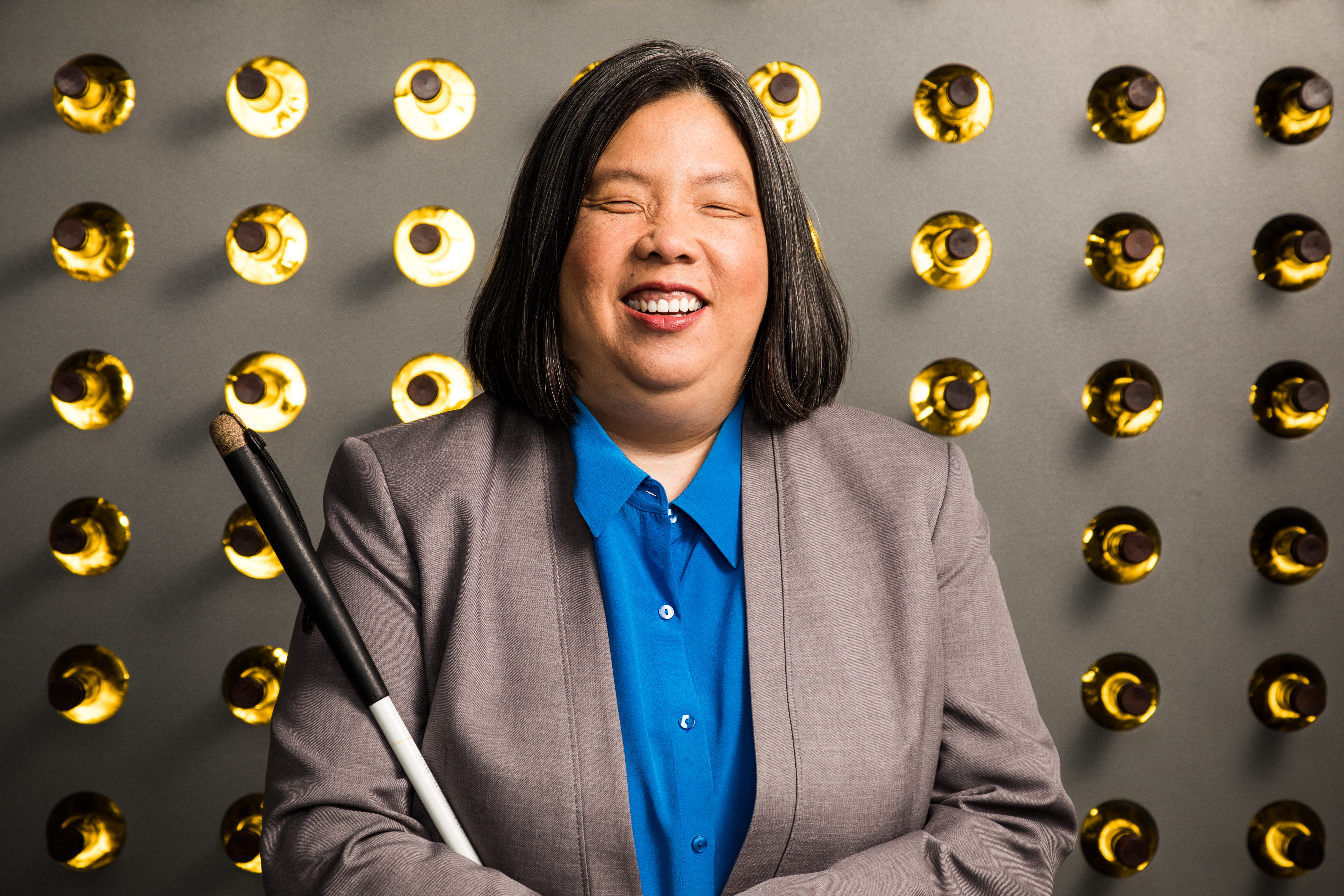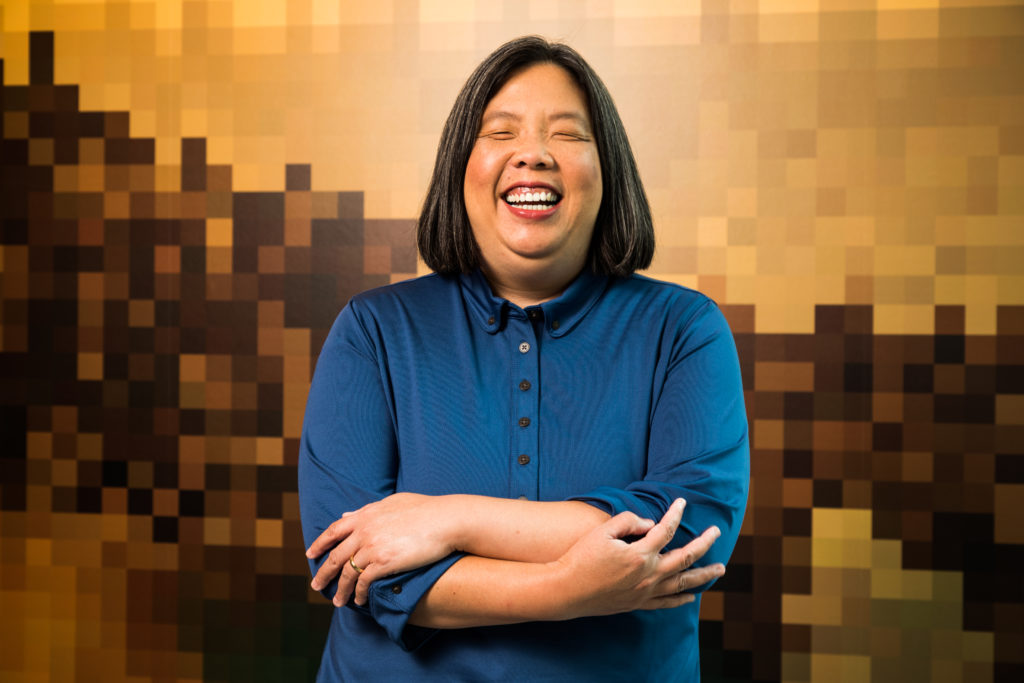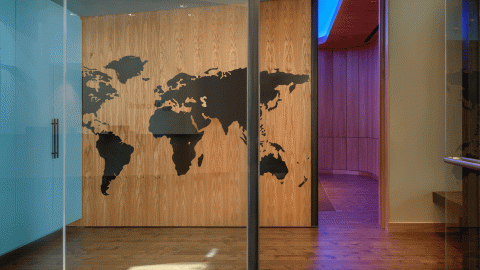‘We are at a crossroads’ – How Microsoft’s Accessibility team is making an impact that will be felt for generations
When it comes to accessibility, Anne Taylor is not afraid to share her point of view. Serving as Director of Supportability in Microsoft’s Accessibility program, she ensures the teams designing Microsoft products and services always consider people with disabilities. She helps engineers understand what does or doesn’t work from an end user’s perspective. Taylor brought her extensive accessibility advocacy experience and knowledge to Microsoft, helping to transform the company’s culture, when she joined in May 2015. During her first year at Microsoft, she became a key member of the Hackathon team that brought Microsoft’s Seeing AI app to market. The app is designed to help people who, like Taylor, are blind, by using their smartphones to describe the world around them.
“We are at a crossroads,” says Taylor. “If we are vigilant and intentional about creating inclusive technology, then tech will level the playing field. If tech doesn’t adopt accessibility as a cause, then I think people with disabilities will be in a worse condition than they were in the past.”
“When it comes to productivity and workforce advancement, there is no other company that has greater impact on individuals who want to stay productive, regardless of their disability, social status, nationality, gender or race.”
At 7, she told her family in her native Thailand that she was determined to live and work in the United States. A scholarship to the Overbrook School for the Blind in Philadelphia helped her achieve that dream, and set her on a career path that would take her from high school and college in Kentucky to Baltimore to serve as the Director of Access Technology at the National Federation of the Blind.
It was during her tenure there that she met Jenny-Lay Flurrie, Microsoft’s Chief Accessibility Officer, who offered her the chance to be an agent of change within Microsoft. Taylor accepted the challenge knowing Microsoft’s senior leadership was supportive of, and enthusiastic about, accessibility as a part of the company’s guiding principles.
In the following Q&A, Taylor shares what she has learned in her career at Microsoft, and what she hopes to achieve in the future.
[Subscribe to Microsoft on the Issues for more on the topics that matter most.]
Was it a difficult decision to join the team at Microsoft?
When it comes to productivity and workforce advancement, there is no other company that has greater impact on individuals who want to stay productive, regardless of their disability, social status, nationality, gender or race.
The unemployment rate among people with disabilities is so incredibly high – 70% among blind people in the U.S. and that is just one group in the disability community. Unemployment is exponentially higher than the national average across all disability segments. So, what better place for me than Microsoft to make sure people with disabilities are represented?
Has that statistic moved at all?
I am not aware that that statistic has significantly improved since 1988 when I first came to the United States.
Is that discouraging?
I look at this with a “glass half-full” attitude and go back to the impact that Microsoft can have, especially when it comes to thought leadership. We can walk the walk as well as talk the talk, and give people an opportunity to succeed. We can do it by putting the needs of our customers first and be willing to take an uncompromising stand on accessibility as we bring more technology into the market.
As we continue to pursue accessibility within our company, we can have an even greater impact across society through knowledge sharing.
“There is a myth that accessibility impedes innovations, but history shows us the opposite is true. Voice recognition technology developed in the late 1970s for patients to operate their wheelchairs is now available in everyone’s phones and cars”
What should businesses do better?
I don’t want to oversimplify – but it’s about people’s attitude to the differences among us. Companies should view disability as a strength. There are over 1 billion people with disabilities globally. Having people with disabilities within the fabric of any company helps ensure that all customers are represented.
That’s especially important now with AI. It can either introduce unnecessary bias or truly represent the needs of people everywhere. Automation is coming in all areas of the workforce, and we need to ensure it doesn’t leave people with disabilities behind. Not too long ago, you could see people with disabilities work in both industrial and office settings. But now when you bring in automation – and you create more complex technology – it can create a gap. If we don’t treat accessibility in a systemic way, it will be hard to correct later.

Microsoft’s President Brad Smith and co-author Carol Ann Browne make this point in their New York Times Best Seller “Tools and Weapons: The Promise and Perils of the Digital Age”: “When your technology changes the world, you bear a responsibility to help address the world that you have helped create.” That is the right sentiment, and that’s a responsibility I hope we all take with the understanding that accessibility and equal access to information is a right for everyone. A part of this responsibility is addressing the lack of technology training in the disability community. The entire industry can do more through implementing education programs for users of all levels to learn to properly use our technologies, and ultimately help decrease the unemployment gap.
In “Tools and Weapons,” Microsoft recognizes it is in a unique position to do this. Everybody has a place in society and a sense of belonging. Our mission is to empower everyone on the planet to achieve more – including people with disabilities.
How do you help bring accessibility into the heart of what Microsoft does on a daily basis?
Working alongside my colleagues from the various engineering teams, I bring the lens of people with disabilities to make sure our products are compliant with accessibility standards. But I want to go beyond compliant. I want to encourage, inspire and motivate teams to think outside the box and innovate with accessibility design as an essential component to any product or service. Let’s cut down on inefficiencies and other frictions, while at the same time creating technologies that are accessible, easy to learn, and have the lowest barrier of entry for everyone. In my discussions with partners across Microsoft, I often remind them that accessibility innovations are not reserved only for specialized assistive technology made for people with disabilities, but they are essential to every product that we create.
There is a myth that accessibility impedes innovations, but history shows us the opposite is true. Innovations such as video captioning for the deaf to access television programs is now used in bars and restaurants everywhere for all people to use, and voice recognition technology developed in the late 1970s at Rehabilitation Medicine in New York for patients to operate their wheelchairs is now available in everyone’s phones and cars. These examples, among others, teach us that accessibility innovations can benefit us all.
Specialized technologies made for and used by people with disabilities, in the industry it’s often called AT – assistive technology. I’d love to call it access technology instead. That’s an empowering term. For those partners who build their AT in Microsoft’s environment, the Accessibility team is maintaining close partnerships with them to provide proper support and encouragement, so that they can create AT that works well in Microsoft’s ecosystem.
Another aspect of my work includes a lot of demonstrations, so I can show people exactly what works well and collaborate on opportunities to improve. Once I have opportunities to surface problems, then we can have meaningful discussions on topics like accessible design, user interface and how people with disabilities are using AT with Microsoft’s products. Accessibility technical excellence can only be achieved when designers and developers collaborate closely with end users with disabilities. We have been able to make progress because of the support from the various engineering teams that I have the privilege to work with. I am very thankful for their partnership and continued commitment.
“A common phrase within our community is ‘nothing about us without us,’ and having people with disabilities at the heart of the design and engineering process is key”
How can the culture of a company change to become more inclusive?
Step one is to hire people with disabilities in your company. A common phrase within our community is “nothing about us without us,” and having people with disabilities at the heart of the design and engineering process is key.
Second, I would encourage corporations and businesses to acknowledge there’s a role for public-private sector partnerships to ensure everyone can stay productive. Many companies’ attitude toward government is, “let us innovate and do what we do best.”
Microsoft is not one of those companies and is not afraid of public-private partnerships in the right context when it comes to showing respect for humanity. You can see that with the thought leadership shown by Brad Smith and his team on privacy regulations and GDPR. I would love to see us playing the same role in accessibility standards and would invite other companies in too. We all have our customers’ interests at heart. Another area that we can do more is supporting third-party partnership. Our partners should know that accessibility is an essential value for Microsoft just like privacy and security. And we are eager to work with them to ensure that they can successfully create accessible products and services using our technology. If we are willing to partner with third parties without bringing accessibility into the discussion, we are not doing enough.
What excites you about the future?
There’s a lot we can do for people with disabilities who rely on alternative formatted content, such as Braille, to stay productive. For example, making graphical illustrations like charts and graphs accessible is still a very manual process. I am interested in whether we can use AI and computer vision to convert those assets into an accessible format to quickly assist users with real-time collaborations.
If we are successful, we can help increase the number of students with disabilities who pursue science, technology, engineering and maths (STEM) subjects. That way we can increase the pipeline of new talent in this area for the tech industry. Mitigating the talent gap is an essential concept – one that Brad also touches upon in ‘Tools and Weapons.’
When given an opportunity, people with disabilities can be successful. And that is the impact Microsoft can have.
For more on Microsoft’s commitment to inclusive products, services and design, visit Microsoft Accessibility and to learn about the the New York Times Best Seller Tools and Weapons: The Promise and the Peril of the Digital Age visit aka.ms/toolsandweaponsbook. And follow @MSFTIssues on Twitter.








